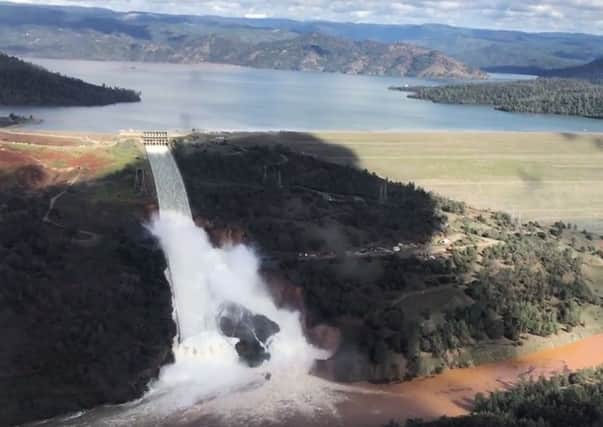Thousands evacuate homes amid California dam overflow fears


There are a lot of unknowns about the situation at the Oroville Dam, about 150 miles north east of San Francisco, Butte County Sheriff Kory Honea said.
A lot of people had to be displaced to ensure public safety and that continues to be his focus, he said.
Advertisement
Hide AdAdvertisement
Hide AdCalifornia fire and rescue chief Kim Zagaris said at least 250 police officers from throughout the state are in the area or en route.
Lake Oroville is about 150 miles north-east of San Francisco, and the 770 ft-tall Oroville Dam is the nation’s tallest. Authorities mentioned a plan to plug the hole by using helicopters to drop rocks into the crevasse.
California Fire Incident commander, Kevin Lawson, said officials stood by the decision to evacuate residents, rather than risk thousands of lives.
He said if the situation was not dealt with they were looking at “a 30ft wall of water coming out of the lake”.
Butte County’s official Twitter feed shared news of emergency shelters, and reported that many hotels were fully booked in the wider area.
One local resident, Javier Santiago, moved his family to the dam’s visitor centre, which sits at the top of the structure and away from the flow of water.
“We’re going to sleep in the car,” he said, adding that he had packed blankets, pillows and a little food for himself, his wife and their two children.
Gurtej Singh, a manager at a Sikh centre in Sacramento, said the local mayor’s office contacted his organisation to ask if they would host evacuees.
Advertisement
Hide AdAdvertisement
Hide Ad“We, in turn, put a call out to members of our community to see if they could provide food, bedding etc, so that around 50 people could stay at our centre,” he said.
Several hours after the evacuation order, the emergency spillway was still standing.
The California Department of Water Resources said it was releasing as much as 100,000 cubic feet of water per second from the main spillway to try to lower the lake’s level and relieve the pressure.
Helicopters were dispatched to drop boulders to try to block the eroded area next to the spillway.
Mr Lawson stressed that there was no danger of the entire dam collapsing.
It rises higher than the spillways, so water was not close to cascading over its top.
Sheriff Honea said that the evacuation was declared to avoid a “worst-case scenario”.
He added that no decision had been made as to when people would be allowed back into their homes, as the authorities were still assessing the risks.
Advertisement
Hide AdAdvertisement
Hide AdDoug Carlson, from the California Department of Water Resources, said that the situation was looking positive, as the lake level had dropped during the night after the emergency measures were taken.
“That’s very good news for the people downstream,” he said.
Bill Croyle, the acting director at the department of water resources, said at a news conference that no corrective measures were taken after looking at the flow and available resources.
He said officials will be able to assess the damage to the emergency overflow now that the water is no longer spilling over the top.
He added that the integrity of the dam has not been impacted.
Last week, water levels in the reservoir rose sharply and the dam’s main spillway, also known as an overflow channel, was found to be damaged.
On Saturday, the water rose even higher, and the emergency spillway was activated for the first time since the dam’s completion in 1968.